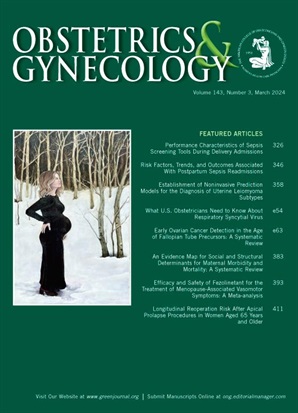怀孕期间亲密伴侣暴力与产后探视的关系。
IF 4.7
2区 医学
Q1 OBSTETRICS & GYNECOLOGY
引用次数: 0
摘要
目的探讨怀孕期间经历情感或身体亲密伴侣暴力(IPV)与产后访视的关系。方法:我们对PRAMS(妊娠风险评估监测系统)2016年至2021年的数据进行了二次分析,PRAMS是一个基于人群的监测系统,收集近期活产妇女孕前、孕期和产后的自我报告信息。我们使用多变量逻辑回归来估计在怀孕期间经历情绪或身体IPV的患病率以及与产后就诊的关联。结果在7个有情感暴力信息的司法管辖区(n= 30333), 3.3% (95% CI, 3.0-3.6)最近活产的妇女报告在怀孕前12个月、怀孕期间或怀孕后经历过任何情感暴力;这些妇女的产后随访率为91.4% (95% CI, 90.9-91.9)。任何情绪性IPV与产后随访的低几率相关(调整后优势比[aOR] 0.74;95% ci, 0.55-0.99)。在48个有物理IPV信息的司法管辖区(n=224,957), 3.3% (95% CI, 3.2-3.5)最近活产的妇女在怀孕前12个月或怀孕期间报告了身体暴力;这些妇女的产后随访率为90.2% (95% CI, 90.0-90.4)。任何物理IPV都与产后随访的低几率相关(aOR 0.63;95% ci, 0.57-0.69)。在产后就诊的妇女中,34.2% (95% CI, 29.0-39.0)经历过情绪性IPV的妇女和35.1% (95% CI, 33.2-37.1)经历过身体性IPV的妇女在就诊期间没有被卫生保健专业人员问及IPV。结论在怀孕期间经历情绪或身体上的IPV与产后就诊的几率较低有关。在远程保健、儿科就诊或家庭健康就诊等各种场所进行筛查,并确保提供IPV筛查和转诊的标准规程和培训,可增加对IPV患者的支持和识别。本文章由计算机程序翻译,如有差异,请以英文原文为准。
Association of Intimate Partner Violence Around the Time of Pregnancy With Postpartum Visits.
OBJECTIVE
To examine the association between experiencing emotional or physical intimate partner violence (IPV) around the time of pregnancy and having a postpartum visit.
METHODS
We conducted a secondary analysis of data from 2016 to 2021 from PRAMS (Pregnancy Risk Assessment Monitoring System), a population-based surveillance system that collects self-reported information about experiences before, during, and after pregnancy among women with a recent live birth. We used multivariable logistic regression to estimate the prevalence of experiencing emotional or physical IPV around the time of pregnancy and associations with having a postpartum visit.
RESULTS
In seven jurisdictions with information on emotional IPV (n=30,333), 3.3% (95% CI, 3.0-3.6) of women with a recent live birth reported experiencing any emotional violence 12 months before pregnancy, during pregnancy, or after pregnancy; for these women, the prevalence of having a postpartum visit was 91.4% (95% CI, 90.9-91.9). Any emotional IPV was associated with lower odds of having a postpartum visit (adjusted odds ratio [aOR] 0.74; 95% CI, 0.55-0.99). In 48 jurisdictions with information on physical IPV (n=224,957), 3.3% (95% CI, 3.2-3.5) of women with a recent live birth reported physical violence 12 months before pregnancy or during pregnancy; for these women, the prevalence of having a postpartum visit was 90.2% (95% CI, 90.0-90.4). Any physical IPV was associated with lower odds of having a postpartum visit (aOR 0.63; 95% CI, 0.57-0.69). Among women who had a postpartum visit, 34.2% (95% CI, 29.0-39.0) of those who experienced emotional IPV and 35.1% (95% CI, 33.2-37.1) of those who experienced physical IPV were not asked about IPV by a health care professional during the visit.
CONCLUSION
Experiencing emotional or physical IPV around the time of pregnancy was associated with lower odds of having a postpartum visit. Conducting screenings at various encounters such as telehealth, pediatric visits, or home health visits and ensuring availability of standard protocols and trainings for IPV screening and referrals may increase support for and identification of women experiencing IPV.
求助全文
通过发布文献求助,成功后即可免费获取论文全文。
去求助
来源期刊

Obstetrics and gynecology
医学-妇产科学
CiteScore
11.10
自引率
4.20%
发文量
867
审稿时长
1 months
期刊介绍:
"Obstetrics & Gynecology," affectionately known as "The Green Journal," is the official publication of the American College of Obstetricians and Gynecologists (ACOG). Since its inception in 1953, the journal has been dedicated to advancing the clinical practice of obstetrics and gynecology, as well as related fields. The journal's mission is to promote excellence in these areas by publishing a diverse range of articles that cover translational and clinical topics.
"Obstetrics & Gynecology" provides a platform for the dissemination of evidence-based research, clinical guidelines, and expert opinions that are essential for the continuous improvement of women's health care. The journal's content is designed to inform and educate obstetricians, gynecologists, and other healthcare professionals, ensuring that they stay abreast of the latest developments and best practices in their field.
 求助内容:
求助内容: 应助结果提醒方式:
应助结果提醒方式:


